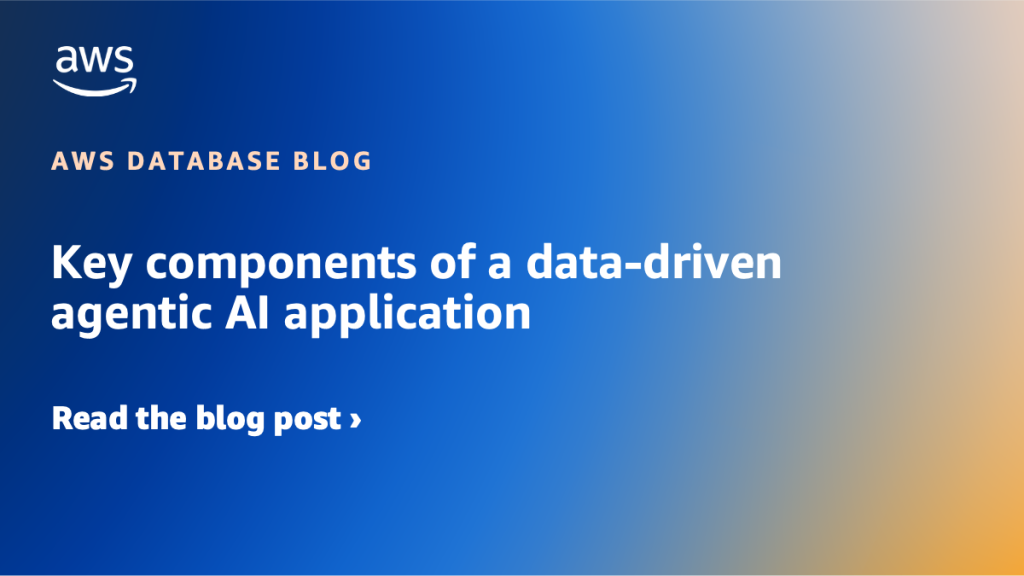AWS Database Blog
Category: Generative AI
AI-powered tuning tools for Amazon RDS for PostgreSQL and Amazon Aurora PostgreSQL databases: PI Reporter
In this post, we explore an artificial intelligence and machine learning (AI/ML)-powered database monitoring tool for PostgreSQL, using a self-managed or managed database service such as Amazon RDS for PostgreSQL and Amazon Aurora PostgreSQL.
Key components of a data-driven agentic AI application
In this post, we look at the costs, benefits, and drawbacks of replacing services for agentic AI with direct database access. Including those that work well and are proven in production, and new services yet to be built. Let’s take a closer look at the anatomy of an agentic AI application and what would factor into such decisions.
Introducing the Amazon DynamoDB data modeling MCP tool
To help you move faster with greater confidence, we’re introducing a new DynamoDB data modeling tool, available as part of our DynamoDB Model Context Protocol (MCP) server. The DynamoDB MCP data modeling tool integrates with AI assistants that support MCP, providing a structured, natural-language-driven workflow to translate application requirements into DynamoDB data models. In this post, we show you how to generate a data model in minutes using this new data modeling tool.
Using generative AI and Amazon Bedrock to generate SPARQL queries to discover protein functional information with UniProtKB and Amazon Neptune
In this post, we demonstrate how to use generative AI and Amazon Bedrock to transform natural language questions into graph queries to run against a knowledge graph. We explore the generation of queries written in the SPARQL query language, a well-known language for querying a graph whose data is represented as Resource Description Framework (RDF).
Integrate natural language processing and generative AI with relational databases
In this post, we present an approach to using natural language processing (NLP) to query an Amazon Aurora PostgreSQL-Compatible Edition database. The solution presented in this post assumes that an organization has an Aurora PostgreSQL database. We create a web application framework using Flask for the user to interact with the database. JavaScript and Python code act as the interface between the web framework, Amazon Bedrock, and the database.
Create a 360-degree master data management patient view solution using Amazon Neptune and generative AI
In this post, we explore how you can achieve a patient 360-degree view using Amazon Neptune and generative AI, and use it to strengthen your organization’s research and breakthroughs. By consolidating information from multiple sources such as electronic health records (EHRs), lab reports, prescriptions, and medical histories into a single location, healthcare providers can gain a better understanding of a patient’s health.
How Iterate.ai uses Amazon MemoryDB to accelerate and cost-optimize their workforce management conversational AI agent
Iterate.ai is an enterprise AI platform company delivering innovative AI solutions to industries such as retail, finance, healthcare, and quick-service restaurants. Among its standout offerings is Frontline, a workforce management platform powered by AI, designed to support and empower Frontline workers. Available on both the Apple App Store and Google Play, Frontline uses advanced AI tools to streamline operational efficiency and enhance communication among dispersed workforces. In this post, we give an overview of durable semantic caching in Amazon MemoryDB, and share how Iterate used this functionality to accelerate and cost-optimize Frontline.
Amazon DynamoDB data models for generative AI chatbots
Amazon DynamoDB is ideal for storing chat history and metadata due to its scalability and low latency. DynamoDB can efficiently store chat history, allowing quick access to past interactions. User-specific metadata, such as preferences and session information, can be stored to personalize responses and manage active sessions, enhancing the overall chatbot experience.In this post, we explore how to design an optimal schema for chatbots, whether you’re building a small proof of concept application or deploying a large-scale production system.
Use a DAO to govern LLM training data, Part 4: MetaMask authentication
In Part 1 of this series, we introduced the concept of using a decentralized autonomous organization (DAO) to govern the lifecycle of an AI model, focusing on the ingestion of training data. In Part 2, we created and deployed a minimalistic smart contract on the Ethereum Sepolia using Remix and MetaMask, establishing a mechanism to govern which training data can be uploaded to the knowledge base and by whom. In Part 3, we set up Amazon API Gateway and deployed AWS Lambda functions to copy data from InterPlanetary File System (IPFS) to Amazon Simple Storage Service (Amazon S3) and start a knowledge base ingestion job, creating a seamless data flow from IPFS to the knowledge base. In this post, we demonstrate how to configure MetaMask authentication, create a frontend interface, and test the solution.
Use a DAO to govern LLM training data, Part 3: From IPFS to the knowledge base
In Part 1 of this series, we introduced the concept of using a decentralized autonomous organization (DAO) to govern the lifecycle of an AI model, focusing on the ingestion of training data. In Part 2, we created and deployed a minimalistic smart contract on the Ethereum Sepolia testnet using Remix and MetaMask, establishing a mechanism to govern which training data can be uploaded to the knowledge base and by whom. In this post, we set up Amazon API Gateway and deploy AWS Lambda functions to copy data from InterPlanetary File System (IPFS) to Amazon Simple Storage Service (Amazon S3) and start a knowledge base ingestion job.









